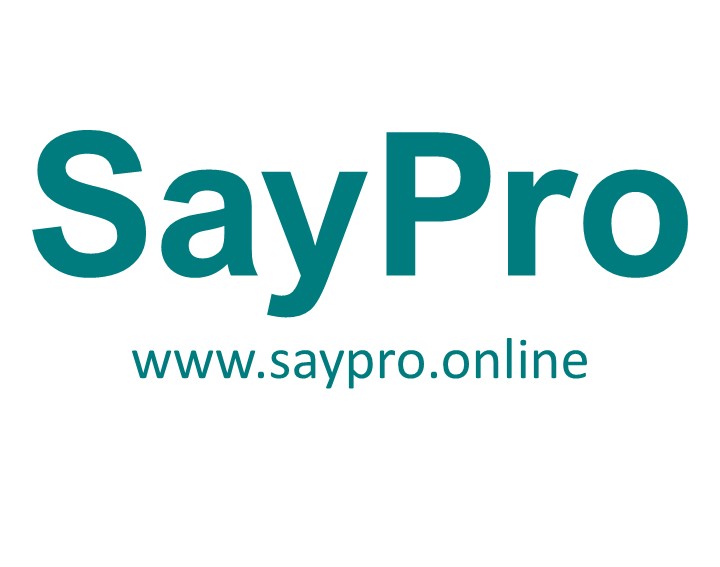 SayPro Event Agenda Template
SayPro Event Agenda Template
Event Title: SayPro 06 June 2025 Health Care Wellness Event
Theme: GBV Awareness & Health Services
Location: [Insert Venue Name & Address]
Date: 06 June 2025
Host: SayPro Human Capital | SayPro Travel and Tourism | SayPro Development Royalty
Approved by: SayPro Royal Committee & CEO Neftaly Malatjie
 Agenda Outline
Agenda Outline
| Time | Session/Activity | Responsible Person/Group | Notes |
|---|---|---|---|
| 08:00 – 08:30 | Arrival, Registration, and Welcome Tea | SayPro Volunteers & Logistics Team | Set up registration desk |
| 08:30 – 08:45 | Opening Remarks | Event Coordinator | |
| 08:45 – 09:15 | Welcome Speech by SayPro CEO Neftaly Malatjie | CEO Neftaly Malatjie | Live-streamed/Recorded |
| 09:15 – 09:30 | Keynote Address on GBV & Wellness | [Insert Speaker Name] | Confirm participation |
| 09:30 – 10:30 | Panel Discussion: Ending GBV through Health Empowerment | Panelists (NGOs, Health Experts) | Moderator needed |
| 10:30 – 11:00 | Health Screening & Medical Booth Tours | Medical Partners | On-site screenings available |
| 11:00 – 11:30 | Dance & Music Performance | Youth Talent Group | Cultural segment |
| 11:30 – 12:00 | Interactive Workshop: Healthy Relationships | Human Capital Facilitators | Separate youth & adult sessions |
| 12:00 – 12:45 | Lunch Break | SayPro Catering Team | Eco-friendly packaging |
| 12:45 – 13:15 | School Learner Awareness Video Screening | AV & Media Team | Video compilation |
| 13:15 – 14:00 | Breakout Sessions (Mental Health, Nutrition, SRHR, etc.) | Partner NGOs & Health Experts | Venue map required |
| 14:00 – 14:30 | Testimonials & Success Stories from Community Members | SayPro Field Staff | Optional video submissions |
| 14:30 – 15:00 | Dance & Singing Performances | School Groups & Community Talent | Confirm schedule with performers |
| 15:00 – 15:30 | Judges & Rewards Ceremony Announcement | Human Capital Lead + Judges Panel | Prizes confirmed |
| 15:30 – 15:45 | Closing Remarks | SayPro Leadership | Event summary + future plans |
| 15:45 – 16:00 | Group Photos, Networking, Social Media Moments | Media Team + Influencers | #SayProWellnessEvent |
 Additional Notes
Additional Notes
- Include a printed and digital copy of the agenda.
- Provide QR codes for session feedback forms.
- Ensure interpreters or multi-language support if needed.
- Set up wellness booths, first aid, and a hydration station throughout the venue.


 SayPro Event Plan Overview
SayPro Event Plan Overview SayPro Event Objectives
SayPro Event Objectives Pre-Event Planning & Coordination
Pre-Event Planning & Coordination SayPro Event Communications & Media
SayPro Event Communications & Media SayPro Event Program & Logistics
SayPro Event Program & Logistics SayPro Event Materials
SayPro Event Materials Engagement, Feedback, and Evaluation
Engagement, Feedback, and Evaluation SayPro Sponsorship & Funding
SayPro Sponsorship & Funding Future Planning
Future Planning What Is the Emergency Contacts & Local Resource List?
What Is the Emergency Contacts & Local Resource List? How Is It Localized?
How Is It Localized? Ambulance & Medical Emergency Services (e.g., Netcare, ER24, government EMS)
Ambulance & Medical Emergency Services (e.g., Netcare, ER24, government EMS) South African Police Service (SAPS) local contact centres
South African Police Service (SAPS) local contact centres Local clinics, hospitals, and poison control centres
Local clinics, hospitals, and poison control centres Gender-based violence support helplines (GBV Command Centre, Thuthuzela Care Centres)
Gender-based violence support helplines (GBV Command Centre, Thuthuzela Care Centres) Emergency contact numbers for local Red Cross or disaster response offices
Emergency contact numbers for local Red Cross or disaster response offices Community social service offices (SASSA, DSD, local NGOs)
Community social service offices (SASSA, DSD, local NGOs) Format and Delivery
Format and Delivery Why It’s Important
Why It’s Important Included with Your Registration:
Included with Your Registration: Certified First Aid Manual (PDF)
Certified First Aid Manual (PDF) Printable First Aid Posters
Printable First Aid Posters Participation Certificate (Digital or Printed)
Participation Certificate (Digital or Printed) 30-Day Access to Online Refresher Course
30-Day Access to Online Refresher Course Email: [Insert Email Address]
Email: [Insert Email Address] Call or WhatsApp: [Insert Phone Number]
Call or WhatsApp: [Insert Phone Number] What Is the SayPro First Aid Refresher Course?
What Is the SayPro First Aid Refresher Course? Access Details
Access Details Who Benefits Most?
Who Benefits Most? Support is available for login help, password resets, or navigation assistance.
Support is available for login help, password resets, or navigation assistance. Participants joining online can also request a printed copy by courier/post (additional fee may apply).
Participants joining online can also request a printed copy by courier/post (additional fee may apply). Certificates will be sent to your email or handed out in person.
Certificates will be sent to your email or handed out in person. Certified First Aid Training Manual (PDF)
Certified First Aid Training Manual (PDF) What’s Inside the Manual?
What’s Inside the Manual? Downloadable before or after the session via email or the SayPro portal
Downloadable before or after the session via email or the SayPro portal Copy of ID or school ID (if under 18)
Copy of ID or school ID (if under 18) A short motivation statement (max 100 words)
A short motivation statement (max 100 words) [Optional] Letter of support for group entries
[Optional] Letter of support for group entries Register here: [Insert Registration Link]
Register here: [Insert Registration Link] Each Participant Will Receive Access To:
Each Participant Will Receive Access To: Posters will be shared via email or SayPro’s portal after the session.
Posters will be shared via email or SayPro’s portal after the session.